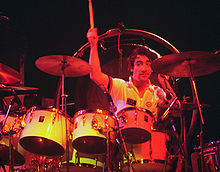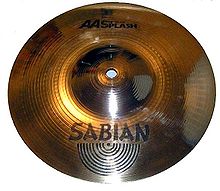Learn to Play Drums/Buying a Drum Kit

This page will go into detail about different types of drum kits and the many accessories that can be a part of a drum kit. Such accessories include drum thrones, drum sticks, cymbals, cymbal sleeves, cymbal stands, bass drum pedals and beaters, and drum heads just to name a few. Do you know what those things all are? If you don’t, you’re about to find out. If you do, then read it anyway – you might find out something you didn’t know.
How much do you want to play drums?
[edit | edit source]Buying a drum kit can be a major investment for some people. You don’t want to hand over a significant amount of money for an instrument you might not end up playing.
If you feel you could play the drums just because you tap along to music on the radio, you could be misled. However, if you find yourself drumming on household objects such as pots and pans, then you're probably ready for the real thing.
Buying
[edit | edit source]Save Money With These Drum Kit Buying Tips! It can be quite frustrating shopping around at different places and wondering whether the kit that you like is actually any good. With all the different name brands out there today - it is hard to blame anyone for being confused. There are numerous drum manufacturers, and each one seems to have five or six different product lines within their brand. I have bought and sold over 40 drum-kits in the last four years, and here are some of the things I've learned.
Important Things to Remember When Shopping For Drums
[edit | edit source]First thing, set your budget before you get started. Be careful not to set it too low as it may take you longer to find the right kit due to the limited selection. This paragraph is for those who are planning on buying a new set of drums, as opposed to a used set of drums. If you are a beginner drummer and just looking for an introductory set then I would recommend a budget of $250-$500 (£155-£310). Beginner kits are generally similar in quality, but there are certain things to look for like cymbal quality, hardware quality, and the pedal response. If you are an intermediate drummer then I would recommend a budget of $600-$1200 (£370-£745). With an intermediate kit you should not have to compromise in terms of your preferences.
For a professional the sky is the limit on what you can spend. There are unlimited limited edition kits. I know that sounds funny but it seems these days that every company is trying to do something new to up the value on their kit.
Buying second-hand
[edit | edit source]
When deciding whether to buy new or used it always comes back to price for me. When buying used equipment, be sure that you are buying from someone that knows how to treat a kit well. Beginner drum-kits never seem to depreciate. I will buy a kit for $250, take it home and sell it the following week for $500. Basically, you need to get a beginner kit for $500 or less. Then when you want to upgrade you will not lose any money. So it is not a question of new or used, it is a question of price. Here are some things to look for when buying a used kit. If the kit needs some work then you can use these to your bargaining advantage.
Cymbals
[edit | edit source]Make sure that there are no cracks or ripples in the cymbals. If there are cracks then consider the cymbal worthless.
Drumheads
[edit | edit source]Check that the heads do not have huge dents or splits in them. Always look at the bottom heads too. They are just as important for the sound quality of your kit.
Hardware
[edit | edit source]I have seen some kits that look as if they were stored in the rain. The hardware was all rusted along with the rims and tuning pegs. If a kit is rusted I recommend that you stay away from it.
Hi-hat stand
[edit | edit source]Try out the hi-hat stand before you buy the kit. Make sure that the spring in the stand is not so worn out that it barely lifts the cymbals.
(Drum) Shells
[edit | edit source]Drum shells are... the (usually) wooden cylinder-shaped things. Check the finish on the drums and make sure that it is not bubbling or peeling. Also, check that the wood is not cracked. What matters most is that you love what you purchased and playing your kit makes you want to keep playing drums. We hope this helps you on your next purchase. Take your time; there is always another good deal out waiting for you. Happy shopping!
Drum kit types
[edit | edit source]There are in general 2 types of drum kits currently available. These comprise of:
Acoustic drum kits
Electric drum kits
There are variations and different types of acoustic drum kits, such as ‘flat’ compact kits.
Acoustic drum kit
[edit | edit source]Acoustic drum kits make up the majority of the drum kits around the country sitting in garages and studios. Generally, acoustic drum kits produce the best sounds but are not very compact.
Pros:
- Better sound
Cons:
- Large – unsuitable for small garages (or wherever you wish to place yours)
- Can’t play for long if you have intolerant neighbours
Electric drum kit
[edit | edit source]Electric drum kits are the lesser used drum kits, but make no mistake; they are still widely used. Electric drum kits have the advantage of being smaller, however they will still take up a large amount of space due to the fact they are positioned the same as other drum kits. These kits run off mains power via a (or a set of) speaker(s).
Pros:
- Generally small
- Light weight
- Adjustable volume – and headphone sockets!
- Hundreds of drum sounds to choose from - means you can 'build' your own drum kit by assigning different sounds to different drums (or rather, pads)
Cons:
- Can’t play in a power cut
- What some consider inferior sound quality
Think!
[edit | edit source]You will really need to think about whether you want to play the drums or not, because they really do cost a lot of money, and so do the accessories. You won't only have to think about the actual drum kit itself, but...
Cymbals (some kits come with cymbals and their stands (referred to as 'Hardware') but they're usually low quality - both the cymbals and their stands)
Drum throne (drum stool - more comfortable to play on and gives you more freedom to move than normal chairs)
Drum sticks (usually come with drum kits but they might not be your preferred size)
These things don't come cheap. For a list of accessories and estimated price ranges, see Accessories
